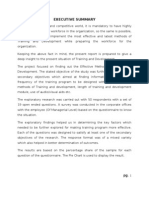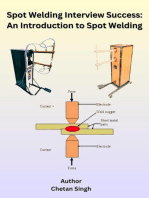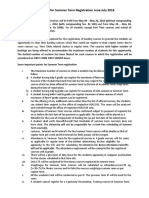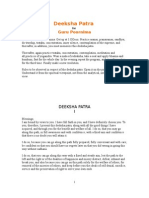Steel India
Steel India
Uploaded by
RamCopyright:
Available Formats
Steel India
Steel India
Uploaded by
RamOriginal Description:
Copyright
Available Formats
Share this document
Did you find this document useful?
Is this content inappropriate?
Copyright:
Available Formats
Steel India
Steel India
Uploaded by
RamCopyright:
Available Formats
AN OVERVIEW OF STEEL SECTOR
Global Scenario
In January-Oct 2019, the world crude steel production reached 1541.77 million tonnes (mt)
and showed a growth of 3.2% over January-Oct 2018.
China remained world’s largest crude steel producer in same period (829.21 mt) followed
by India (93.31 mt), Japan (83.79 mt) and the USA (74.07 mt).
World Steel Association has projected Indian steel demand to grow by 5% in 2019 while
globally, steel demand has been projected to grow by 3.9% in 2019. Chinese steel use is
projected to show 7.8% growth in 2019.
Per capita finished steel consumption in 2018 was 224.5 kg for world and 590.1 kg for
China (Source: World Steel Association). The same for India was 74.1 kg in 2018 (Source:
JPC).
Note: World Steel Association report, Data Provisional
Domestic Scenario
The Indian steel industry has entered into a new development stage, post de-regulation,
riding high on the resurgent economy and rising demand for steel.
Rapid rise in production has resulted in India becoming the 2nd largest producer of crude
steel during 2018, from its 3rd largest status in 2017. The country is also the largest producer
of Sponge Iron or DRI in the world and the 3rd largest finished steel consumer in the world
after China & USA.
In a de-regulated, liberalized economic/market scenario like India the Government’s role
is that of a facilitator which lays down the policy guidelines and establishes the institutional
mechanism/structure for creating conducive environment for improving efficiency and
performance of the steel sector.
In this role, the Government has released the National Steel Policy 2017, which has laid
down the broad roadmap for encouraging long term growth for the Indian steel industry,
both on demand and supply sides, by 2030-31. The Government has also announced a
policy for providing preference to domestically manufactured Iron & Steel products in
Government procurement.
Production
Steel industry was de-licensed and de-controlled in 1991 & 1992 respectively.
India is currently the 2nd largest producer of crude steel in the world.
In 2018-19, production of total finished steel (alloy/stainless + non alloy) was 101.287
million tonnes (mt).
Production of Pig Iron in 2018-19 was 6.414 mt, a growth of 11.9% over last year.
India is the largest producer of Sponge Iron in the world. The coal based route accounted
for 79% of total Sponge Iron production (34.71 mt) in the country in 2018-19.
Data on production of Pig Iron, Sponge Iron and Total Finished Steel (alloy/stainless +
non-alloy) are given below for last five years and April-October 2019-20 (prov.):
JPC: upto Oct 2019 1
Indian steel industry : Production (in million tonnes)
Category 2014-15 2015-16 2016-17 2017-18 2018-19 April-
October
2019-20*
Pig Iron 10.23 10.24 10.34 5.73 6.41 3.43
Sponge Iron 24.24 22.43 28.76 30.51 34.71 21.27
Total Finished Steel^ 104.58 106.60 120.14 126.85 101.29 59.73
Source: Joint Plant Committee; *prov.; For Details, please refer to appendix
^ Upto 2017-18, production of finished steel includs value added product
Demand - Availability
Industry dynamics including demand – availability of iron and steel in the country are
largely determined by market forces and gaps in demand-availability are met mostly
through imports.
Interface with consumers exists by way of meeting of the Steel Consumers’ Council, which
is conducted on regular basis.
Interface helps in redressing availability problems, complaints related to quality.
Steel Prices
Price regulation of iron & steel was abolished on 16.1.1992. Since then steel prices are
determined by the interplay of market forces.
Domestic steel prices are influenced by trends in raw material prices, demand – supply
conditions in the market, international price trends among others.
As a facilitator, the Government monitors the steel market conditions and adopts fiscal and
other policy measures based on its assessment. Currently, GST of 18% is applicable on
steel and there is no export duty on steel items.
A Steel Price Monitoring Committee has been constituted by the Government with the aim
to monitor price rationalization, analyse price fluctuations and advise all concerned
regarding any irrational price behaviour of steel commodity.
To avoid any distortion in prices in view of ad-hoc and rising imports, the Government had
taken several steps including raising import duty and imposed a gamut of measures
including anti-dumping and safeguard duties on a host of applicable iron and steel items.
In a further move to curb steel imports, the Indian government banned the production and
sale of steel products that does not meet Bureau of Indian Standard (BIS) approval and to
check the sale of defective and sub-standard stainless steel products used for making
utensils and various kitchen appliances, it issued the Stainless Steel (Quality Control)
Order, 2016 for products used in making utensils and kitchen appliances, that will help
filter imports of the metal.
Imports
Iron & steel are freely importable.
Data on import of total finished steel (alloy/stainless + non alloy) is given below for last
five years and April-October 2019-20 (prov.):
JPC: upto Oct 2019 2
Indian steel industry : Import of Total Finished Steel (in million tonnes)
Category 2014-15 2015-16 2016-17 2017-18 2018-19 April-October 2019-20*
Qty 9.32 11.71 7.23 7.48 7.83 4.65
Source: Joint Plant Committee; *prov.
Exports
Iron & steel are freely exportable.
India emerged as a net exporter of total finished steel in 2016-17 and 2017-18, also in
April-October 2019-20.
Data on export of total finished steel (alloy/stainless + non alloy) is given below for last
five years and April-October 2019-20 (prov.):
Indian steel industry : Export of Total Finished Steel (in million tonnes)
Category 2014-15 2015-16 2016-17 2017-18 2018-19 April-October 2019-20*
Qty 5.59 4.08 8.24 9.62 6.36 4.89
Source: Joint Plant Committee; *prov.
Levies on Iron & Steel
SDF levy: This was a levy started for funding modernisation, expansion and development of
steel sector. The Fund, inter-alia, supports Capital expenditure for modernisation,
rehabilitation, diversification, renewal & replacement of Integrated Steel Plants, Research &
Development, Rebates to SSI Corporations among others. The SDF levy was abolished on
21.4.94. An Empowered Committee has been set up to guide the R&D effort in this sector.
EGEAF: This levy started for reimbursing the price differential cost of inputs used for
engineering exporters. Fund was discontinued on 19.2.96.
Opportunities for growth of Iron and Steel in Private Sector
The New Industrial Policy Regime
The New Industrial policy opened up the Indian iron and steel industry for
private investment by (a) removing it from the list of industries reserved for public sector and
(b) exempting it from compulsory licensing. Imports of foreign technology as well as foreign
direct investment are now freely permitted up to certain limits under an automatic route.
Ministry of Steel plays the role of a facilitator, providing broad directions and assistance to
new and existing steel plants, in the liberalized scenario.
JPC: upto Oct 2019 3
The Growth Profile
(i) Steel : The liberalization of industrial policy and other initiatives taken by the Government
have given a definite impetus for entry, participation and growth of the private sector in the
steel industry. While the existing units are being modernized/expanded, a large number of new
steel plants have also come up in different parts of the country based on modern, cost effective,
state of-the-art technologies. In the last few years, the rapid and stable growth of the demand
side has also prompted domestic entrepreneurs to set up fresh greenfield projects in different
states of the country.
Crude steel capacity was 142.24 mt in 2018-19, up by 3.1% over 2017-18 and India, which
emerged as the 2nd largest producer of crude steel in the world in 2018, as per data released by
the World Steel Association, has to its credit, the capability to produce a variety of grades and
that too, of international quality standards.
(ii) Pig Iron: India is also an important producer of pig iron. Post-liberalization, with setting
up several units in the private sector, not only imports have drastically reduced but also India
has turned out to be a net exporter of pig iron. The private sector accounted for 91% of total
production of pig iron (6.414 mt) in the country in 2018-19.
(iii) Sponge Iron: India, world’s largest producer of sponge iron (2018), has a host of coal
based units located in the mineral-rich states of the country. Over the years, the coal based
route has emerged as a key contributor and accounted for 79% of total Sponge Iron production
in the country. Capacity in Sponge Iron making too has increased over the years and stood at
46.56 mt (2018-19).
---------------------------------
JPC: upto Oct 2019 4
Appendix
i) As per the reporting system followed by Joint Plant Committee (JPC), which is authorized by the
Ministry of Steel to collect and disseminate data on the domestic iron and steel industry, the said system
prevailing till 2013-14 had (a) reported on the concept of production for sale and (b) featured the
“Main Producers” and “Majors and Other Producers” as the two leading industry classifications at
that time. However, effective from 2017-18, with the approval of the Ministry of Steel and following
rounds of interaction with industry experts, the JPC reporting system had changed, in sync with the
changing dynamics and mode of operation of steel industry and partly also in response to changes in
the policy environment. Under the new system, production for sale has been replaced by Gross
Production (or simply Production) with revision in past five years data as well. Secondly, with industry
classification system getting dissolved vide guidelines issued by the Ministry of Steel in May 2016, the
present JPC reporting system features (a) the composite group of “SAIL, RINL, TSL, ESL, JSW, JSPL”
and that of “Other Producers”.
ii) The issue of data collection and reporting by JPC was reviewed in details at various forum of
interaction sessions with industry representatives as well as Ministry of Steel and it was felt that given
the structural changes in the domestic steel industry as well as the present input-output dynamics, the
data reporting system followed by JPC should undergo some modifications. The following
modifications were made in JPC reporting system from 2018-19:-
a) It introduces the method of Crude Steel to HR equivalent, covering only those items which
contribute directly to Finished Steel Production starting from Crude Steel/Semis Production.
b) It thus separates out Downstream and Value-Added Product Basket (CR/GP etc) which is reported
separately. There is, however, no aggregate numbers of these parameters for the items in this
Basket.
c) Also, data on imports, exports, stock variation and consumption of items featured in this Basket
are available with JPC and are reported accordingly.
d) Steel Consumption is arrived at by standard procedure of adjusting Finished Steel Production
with Net Imports and Stock Variation, computed by using all items across the value chain, so as
to ensure no loss of data.
e) Per capita steel consumption is computed by using steel consumption numbers as arrived at above
and population for the country as reported by Central Statistical Organisation (CSO), Ministry of
Statistics and Programme Implementation.
However, it may be noted, that all throughout such changes, the system of reporting by JPC continues
to be for statistical use only.
----------------------------------
JPC: upto Oct 2019 5
You might also like
- Project Report On Vizag Steel Plant Distribution ChannelDocument94 pagesProject Report On Vizag Steel Plant Distribution ChannelOm Prakash78% (9)
- National Steel Policy 2017Document4 pagesNational Steel Policy 2017Rakesh PrasadNo ratings yet
- An Overview of Steel Sector - Updtd Dec 2018Document4 pagesAn Overview of Steel Sector - Updtd Dec 2018thoolakshay193No ratings yet
- Overview of Steel - MOSDocument5 pagesOverview of Steel - MOSSamit SenNo ratings yet
- Jaya BlackBook Final1Document75 pagesJaya BlackBook Final1SauravNo ratings yet
- Iron and Steel Industry: Economics AssignmentDocument10 pagesIron and Steel Industry: Economics Assignmentsamikshya choudhuryNo ratings yet
- Steel Industry in IndiaDocument8 pagesSteel Industry in IndiaakashNo ratings yet
- 19PT2-23 MA AssignmentDocument19 pages19PT2-23 MA AssignmentHardeep SinghNo ratings yet
- An Overview of Steel SectorDocument3 pagesAn Overview of Steel SectorAnand SagarNo ratings yet
- FinMod Final AssignmentDocument17 pagesFinMod Final Assignmentvirat kohliNo ratings yet
- Iron IndiaDocument7 pagesIron Indiaganesh kNo ratings yet
- Project KamleshDocument103 pagesProject Kamleshdeep1aroraNo ratings yet
- Steelplant SeminarDocument28 pagesSteelplant SeminarBharat L. YeduNo ratings yet
- Tata SteelDocument27 pagesTata SteelJAYKISHAN JOSHI50% (4)
- Overview of Iron and Steel Industry: Chapter-IiDocument24 pagesOverview of Iron and Steel Industry: Chapter-IiRahul NiranwalNo ratings yet
- Sub: Strategic Management: Steel IndustryDocument13 pagesSub: Strategic Management: Steel IndustryRohit GhaiNo ratings yet
- Steel Industry in India AbstractDocument8 pagesSteel Industry in India AbstractPawan Kumar VulluriNo ratings yet
- Shishir 2.1 To 2.4Document4 pagesShishir 2.1 To 2.4Shishir KumarNo ratings yet
- An Overview of Steel Sector_1Document8 pagesAn Overview of Steel Sector_1vpraveen6831No ratings yet
- Steel Industry Overview ReportDocument92 pagesSteel Industry Overview ReportAnkit SinghNo ratings yet
- Steel Has An Oligopoly Market IDocument6 pagesSteel Has An Oligopoly Market Iarchana783No ratings yet
- Salma Final Report 12345Document29 pagesSalma Final Report 12345ArsenalAfreedAhmedNo ratings yet
- Steel TypeDocument15 pagesSteel TypeYadav KrishnaNo ratings yet
- Steel BrochureDocument12 pagesSteel BrochureHARSH SinghaniaNo ratings yet
- Steel March 220313Document38 pagesSteel March 220313mahmood750No ratings yet
- Internship ReportDocument41 pagesInternship ReportPankaj KumarNo ratings yet
- An Overview of The Steel Industry: Group Number: 6Document9 pagesAn Overview of The Steel Industry: Group Number: 6MohitNo ratings yet
- Combined Research PaperDocument11 pagesCombined Research PaperSibikshaNo ratings yet
- Analysis of Results (1)Document13 pagesAnalysis of Results (1)shruti.lalNo ratings yet
- Steel February 2020Document35 pagesSteel February 2020Jayesh RamnaniNo ratings yet
- Research Project On Steel IndustryDocument30 pagesResearch Project On Steel IndustryRitu BhatiyaNo ratings yet
- Industry Profile: Steel Industry Is Becoming More and More Competitive With Every Passing Day. During TheDocument19 pagesIndustry Profile: Steel Industry Is Becoming More and More Competitive With Every Passing Day. During Thevinay8464No ratings yet
- Steel IndustryDocument28 pagesSteel Industryrohitmahato10No ratings yet
- National Steel Policy 2017Document31 pagesNational Steel Policy 2017Jagdish AroraNo ratings yet
- Steel IndusrtyDocument9 pagesSteel Indusrtyharish333prasadNo ratings yet
- CH 2 CP - 1Document11 pagesCH 2 CP - 1PearlNo ratings yet
- India Circular Economy Goals Spotlight Ferrous ScrapDocument13 pagesIndia Circular Economy Goals Spotlight Ferrous ScrapKunal BanerjeeNo ratings yet
- Report of The Working Group On Steel Industry For The Eleventh Five-Year Plan (2007-2012)Document207 pagesReport of The Working Group On Steel Industry For The Eleventh Five-Year Plan (2007-2012)Sushant PatilNo ratings yet
- Overview of Steel IndustryDocument29 pagesOverview of Steel IndustryJaimin SarvaiyaNo ratings yet
- Iron and Steel Industry in IndiaDocument16 pagesIron and Steel Industry in IndiaAnonymous gQyrTUHX38100% (1)
- Sail ProjectDocument69 pagesSail ProjectBhoomika SrivastavaNo ratings yet
- Steel IndustryDocument9 pagesSteel IndustryMayank AgarwalNo ratings yet
- About Steel Industry Manufacturing and CA OpportunitiesDocument7 pagesAbout Steel Industry Manufacturing and CA Opportunitiescmeps81No ratings yet
- Production and Consumption Trends in The Total Finished Steel Market (In Million Tonnes)Document6 pagesProduction and Consumption Trends in The Total Finished Steel Market (In Million Tonnes)Monish RcNo ratings yet
- Safety Guidelines For Iron and Steel SectorDocument435 pagesSafety Guidelines For Iron and Steel SectorLalatendu MahantaNo ratings yet
- AStudyon Performanceand Prospectof Indian Steel Industryfrom National Perspective Under GlobalizationDocument9 pagesAStudyon Performanceand Prospectof Indian Steel Industryfrom National Perspective Under GlobalizationNiketa Govind KhalkhoNo ratings yet
- PWC PDFDocument28 pagesPWC PDFkeanuNo ratings yet
- Steel June 2019Document34 pagesSteel June 2019Vismay RahangdaleNo ratings yet
- Steel Industry in IndiaDocument2 pagesSteel Industry in IndiaKuber BishtNo ratings yet
- Market Structure-Indian Steel SectorDocument6 pagesMarket Structure-Indian Steel SectorRakesh RanjanNo ratings yet
- Precision Steel TubesDocument9 pagesPrecision Steel TubesRam KumarNo ratings yet
- Steel Industry in India: Project FinanceDocument32 pagesSteel Industry in India: Project FinanceSharvil Vikram Singh100% (1)
- Economics (Sree)Document45 pagesEconomics (Sree)steevejan541No ratings yet
- Iron & Steel Industry in IndiaDocument18 pagesIron & Steel Industry in IndiaRahul KolekarNo ratings yet
- Eco Project ReportDocument21 pagesEco Project Reportswapnil_thakre_1No ratings yet
- Spot Welding Interview Success: An Introduction to Spot WeldingFrom EverandSpot Welding Interview Success: An Introduction to Spot WeldingNo ratings yet
- The Pentagon, Climate Change, and War: Charting the Rise and Fall of U.S. Military EmissionsFrom EverandThe Pentagon, Climate Change, and War: Charting the Rise and Fall of U.S. Military EmissionsNo ratings yet
- Cast Iron Soil Pipe & Fittings & Special Fittings, Gray Iron World Summary: Market Sector Values & Financials by CountryFrom EverandCast Iron Soil Pipe & Fittings & Special Fittings, Gray Iron World Summary: Market Sector Values & Financials by CountryNo ratings yet
- JD-UI DeveloperDocument1 pageJD-UI DeveloperRamNo ratings yet
- JD For Lead Software Engineer (Frontend) at Supr DailyDocument7 pagesJD For Lead Software Engineer (Frontend) at Supr DailyRamNo ratings yet
- JD For Sr. Software Engineer (Frontend) at Supr DailyDocument7 pagesJD For Sr. Software Engineer (Frontend) at Supr DailyRamNo ratings yet
- Mid Semester 2017181Document19 pagesMid Semester 2017181RamNo ratings yet
- New Doc 2017-04-28Document45 pagesNew Doc 2017-04-28RamNo ratings yet
- System: Installation and Maintenance ManualDocument60 pagesSystem: Installation and Maintenance ManualCid FreitasNo ratings yet
- 2009 Longleaf Flatwoods ReserveDocument71 pages2009 Longleaf Flatwoods Reservebradley_waltersNo ratings yet
- Negotiable Instruments Law - Case Digest - Dean Jose R. Sundiang - Renz J. Pagayanan - San Beda College of LawDocument24 pagesNegotiable Instruments Law - Case Digest - Dean Jose R. Sundiang - Renz J. Pagayanan - San Beda College of LawRenz Pagayanan89% (18)
- Discourse Analysis: Assist. Prof. Muhsin YanarDocument23 pagesDiscourse Analysis: Assist. Prof. Muhsin YanarDudu Nur DemirNo ratings yet
- FruchterDocument3 pagesFruchterhaltovskyNo ratings yet
- Thesis On Consumer Buying BehaviourDocument6 pagesThesis On Consumer Buying Behaviourafkokocqw100% (1)
- Assembly Language ProgrammingDocument20 pagesAssembly Language ProgrammingRaj Kumar100% (3)
- SST Art Integrated ProjectDocument13 pagesSST Art Integrated ProjectANo ratings yet
- Robeco SAM Measuring IntangiblesDocument20 pagesRobeco SAM Measuring IntangiblesGagan ChoudharyNo ratings yet
- SQ505638 - Aayan Al Nokhba-MVE Spare Parts-Rev-00Document10 pagesSQ505638 - Aayan Al Nokhba-MVE Spare Parts-Rev-00mostafa husseinNo ratings yet
- Cultural Environment Facing BusinessDocument18 pagesCultural Environment Facing BusinessapiconpikkNo ratings yet
- Ap 10 Gear PumpDocument2 pagesAp 10 Gear PumpwxxnhykpxgNo ratings yet
- 03 DUDir South Campus, 2020 IIDocument11 pages03 DUDir South Campus, 2020 IInew traineeeNo ratings yet
- HCC IndustriesDocument8 pagesHCC IndustriesChloe MillsNo ratings yet
- Mayella Ewell - RevisedDocument2 pagesMayella Ewell - RevisedVineeth YeevaniNo ratings yet
- A Little Sweet 有點甜 (You Dian Tian)Document5 pagesA Little Sweet 有點甜 (You Dian Tian)hafish varintioNo ratings yet
- Flyover: A Urban Void: Infrastructural Barrier or A Potential Opportunity For Knitting The City Fabric ?Document14 pagesFlyover: A Urban Void: Infrastructural Barrier or A Potential Opportunity For Knitting The City Fabric ?Dileep KumarNo ratings yet
- 1 - Introduction To Emerging Technologies PDFDocument77 pages1 - Introduction To Emerging Technologies PDFFrinzcharls Dajao DavocolNo ratings yet
- Catering Menu Catering Menu: Special EventsDocument19 pagesCatering Menu Catering Menu: Special Eventsstephanie_iovienoNo ratings yet
- Guidelines For Summer Term RegistrationDocument6 pagesGuidelines For Summer Term RegistrationRahul Arora0% (1)
- Painting 15mm German TutorialDocument3 pagesPainting 15mm German Tutorialapi-117718285No ratings yet
- Kōan - WikipediaDocument17 pagesKōan - WikipediarippvannNo ratings yet
- Full Syn 10W 30Document2 pagesFull Syn 10W 30Rafael MejiaNo ratings yet
- Initiation Instructions in Tantra YogaDocument19 pagesInitiation Instructions in Tantra Yogaanonyogi100% (1)
- Occupied House Property: Computation of Income From A SelfDocument34 pagesOccupied House Property: Computation of Income From A SelfVarun SinghviNo ratings yet
- Przyimki Ruchu CwiczeniaDocument2 pagesPrzyimki Ruchu CwiczeniaMartyna TołczNo ratings yet
- Resume For MaintenanceDocument7 pagesResume For Maintenanceaqquwuekg100% (1)
- Appsc Polytechnic Lecturers 19-05-2011Document9 pagesAppsc Polytechnic Lecturers 19-05-2011बोले तो भरद्वाजNo ratings yet
- What Is Happiness Analysis EssayDocument3 pagesWhat Is Happiness Analysis Essayncosby20% (1)
- Cambridge English First Fce From 2015 WritingDocument7 pagesCambridge English First Fce From 2015 WritingMGK21No ratings yet






























































































